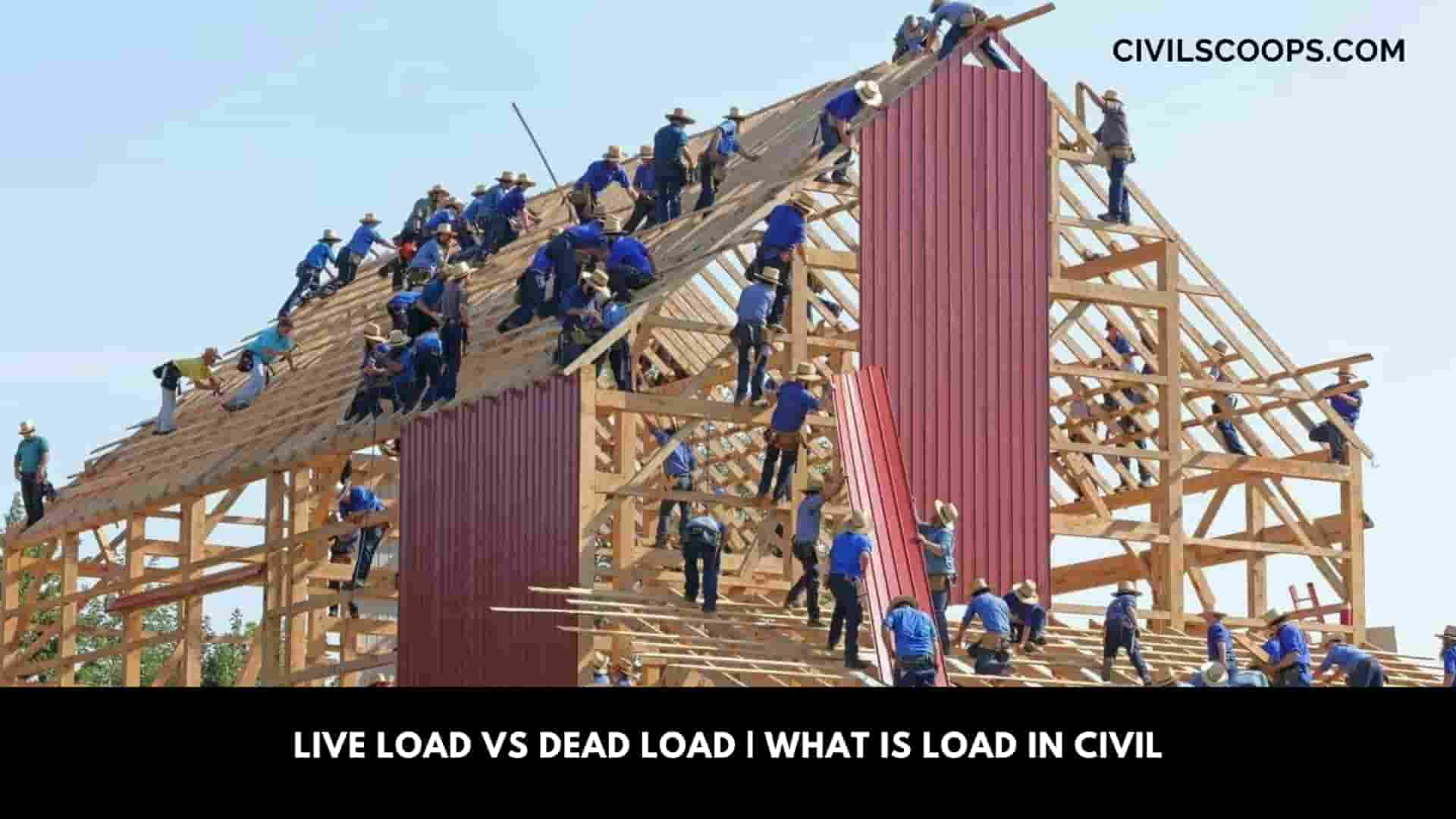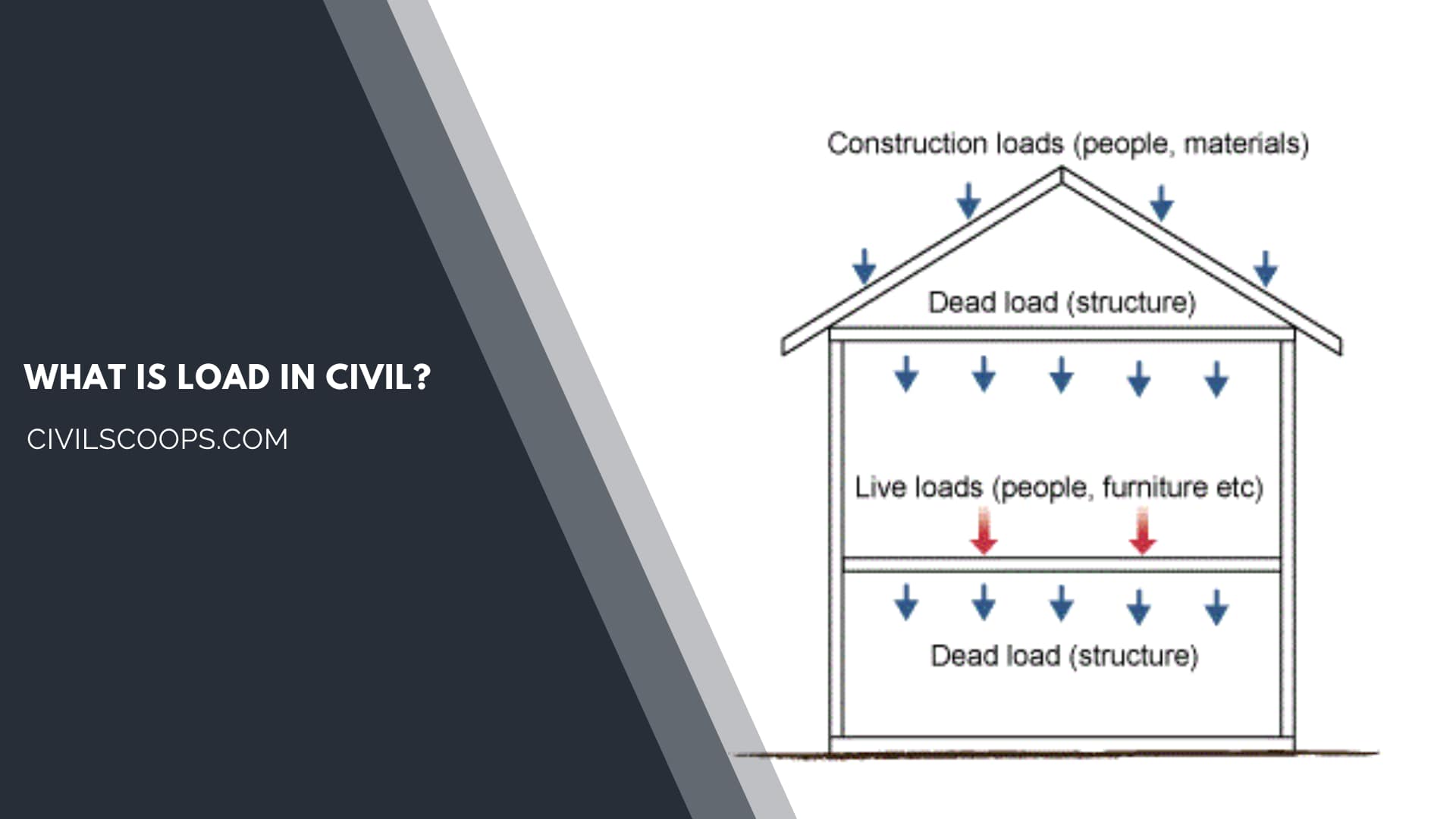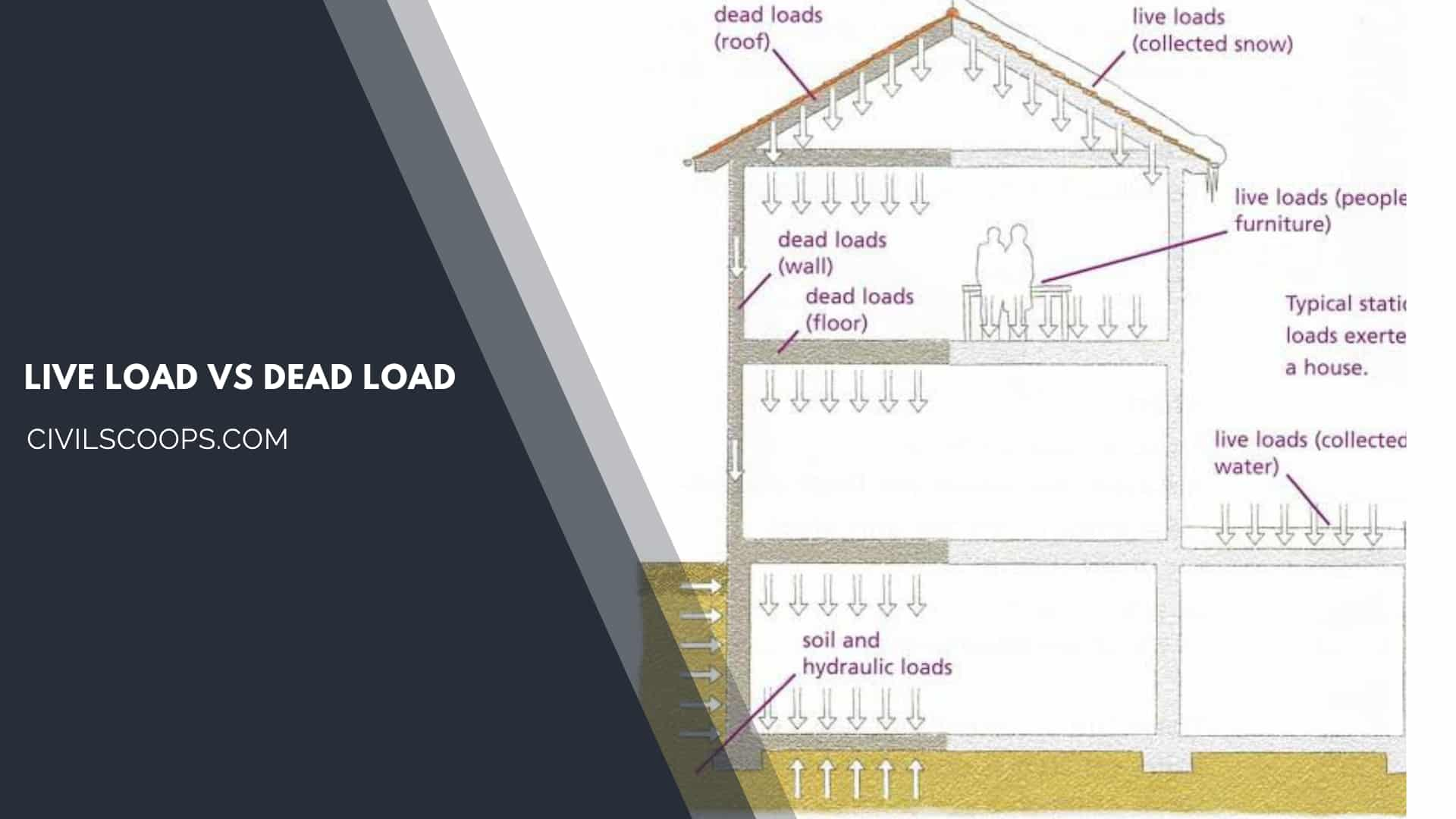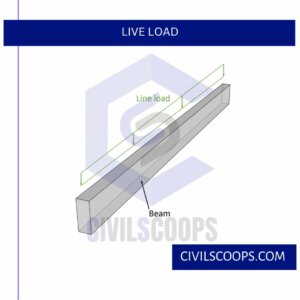Live Load Vs Dead Load | What Is Load in Civil

Table of Contents
What Is Load in Civil?

There are different types of load than working on a structure, the design, location, and similar nature of which will vary. Design requirements are usually specified in terms of the maximum load that a structure must be able to withstand.
The load is usually classified as either dead load or live load. Dead loads, also known as permanent or static loads, are those that remain relatively constant over time and, for example, the weight of structural elements of a building, such as beams, walls, ceilings, and structural floors. Component.
Dead loads may include permanent non-structural partitions, fixed fixtures, and even built-in cupboards. Live loads (applied or imposed loads) may vary over time. Typical live loads may include audience weight in an auditorium.
Live Load Vs Dead Load

Dead Load-

Dead loads are static forces that are relatively constant for an extended time. They can be in tension or compression. The term can refer to a laboratory test method or to the normal usage of a material or structure.
In short, the dead weight of a structure includes its full weight, usually measured in pounds per square foot before it goes into service.
Floors, walls, ceilings, columns, staircases, permanent appliances, and any fixed decoration create a static load that does not typically change over the life of the building.
To quote Nischian again: “[D] loads account for non-dynamic forces having constant and permanent force on a structure.”
Therefore, the calculation of dead load, the weight of its components, and pressures applied in a downward direction from the ground before taking additional load from living or use in a building must include the foundation system, the construction material employed, and concrete for any service.
Equipment such as elevators, and ductwork, plumbing, fixed manufacturing equipment, etc.
Also Read: Load-Bearing Vs Partition Walls | What Are Walls | Classified of Walls
Useful Article for You
- What Is a Highway Flyover
- What Is Grouting
- What Is a Pile Cap
- What Is a Bond Beam in Masonry
- What Is Sapwood
- What Is Crane
- What Is a Gable
- What Is Superelevation
- What Is Kerb
- What Is the Purpose of Washers
- What Is the Size of a Brick in Inches
- What Is Reinforced Masonry
- What Is Workability
- What Is Bond Breaker
- What Is Plasticizer in Concrete
- What Is Luminous Flux Vs Lumens
- What Is Caisson
- What Is an Undercoat
- What Is a Benchmark Surveying
- What Is Bracing in Construction
- What Is a Beam in Construction
- What Is the Standard Door Frame Size
- What Is a Spandrel Beam
- What Is a Fire Escape
- What Is a Weep Hole
- What Is Tie Beam
- What Is Fine Aggregate
- What Is Pony Wall
- What Is Flag Stone
- What Is Development Length
- What Is Cement Plaster
- What Is a Pitched Roof
- What Is Rafters
- What Is a Slab in Construction
- What Is a Monolithic Slab
- What Is Linear Distance
Live Load-

Live loads are usually variable or moving loads. These can have a significant dynamic element and may involve considerations such as impact, momentum, vibration, slosh dynamics of fluids, etc.
Live load refers to occupational forces from occupancy and intended use. They represent transient forces that can be moved through the building or act on a particular structural element.
Also measured in PSF, these weights include people’s estimated weights, furniture, appliances, automobiles, movable equipment, and the like.
The American Society of Civil Engineers (ASCE) requires that the minimum live load in the design should always exceed the maximum anticipated live load during the life span of the building in the Caseloads.
ASCE guidelines set live loads according to categories of occupancy and use per building type.
Because live load depends on structural strength, knowledge of the exact planned use of the building is important. The lack of dead load, or lack thereof, often defines how much live weight it can handle.
Reinforced concrete forms the heaviest load, but also supports the most weight with its tremendous compressive strength.
Structural steel provides very little of a dead load and provides better support for live loads in multi-story buildings. Natural and engineered wood rest relatively lightly on foundations but support a lower live load than steel and concrete.
Also Read: All About Wood | Types of Wood | What Is Wood | Advantages of Wood
Environmental Regulations:
Before an edifice can pass the requirements, the structural design must also subsequently include other dynamic loads acting on it.
These environmental loads can come from snow, soil movement, and seismic activity. Naturally, Colorado Front Range codes are mild on seismic control, but certainly a factor of extreme snow, wind, and soil conditions.
The different types classified as vertical loads, horizontal loads, and longitudinal loads. Vertical loads include dead loads, live loads, and impact loads.
Horizontal loads include wind loads and earthquake loads. Longitudinal loads, i.e. tractive and braking forces, are considered in special cases of design of bridges, gantry girders, etc.
The Types of Loads Acting on a Structure Are:
- Dead Weight.
- Load applied.
- Wind load.
- Snow Weight.
- Earthquake load.
- Special load.
Calculate the volume of the slab and multiply the density of the material from which it is made.
For example, if you are working with a rectangular prismatic slab, you would multiply the area of the slab’s thickness and the resulting time density (for concrete, it is 2200 to 2400 kg per cubic meter).
Once you have mass, it multiplies gravity to increase weight, which is the dead load. This is a concentrated load, so you should distribute it on the surface of the slab.
As it may be noted that the phase thickness of the multiplication of the field is redundant, because, in the end, you would divide it at the same value, but I pointed it out because I think it is conceptually important.
[su_box title=”FAQ” style=”default” box_color=”#333333″ title_color=”#FFFFFF” radius=”3″ class=”” id=””]
Live Load Vs Dead Load
The dead loads are permanent loads which result from the weight of the structure itself or from other permanent attachments, for example, drywall, roof sheathing and weight of the truss. Live loads are temporary loads; they are applied to the structure on and off over the life of the structure.
Dead Load and Live Load
Dead loads (DL) are essentially constant during the life of the structure and normally consist of the weight of the structural elements. On the other hand, live loads (LL) usually vary greatly. The weight of occupants, snow and vehicles, and the forces induced by wind or earthquakes are examples of live loads.
What Is Dead Load?
a constant load in a structure (such as a bridge, building, or machine) that is due to the weight of the members, the supported structure, and permanent attachments or accessories.
Roof Dead Load
Dead loads consist of the permanent construction material loads. comprising the roof, floor, wall, and foundation systems, including claddings, finishes, and fixed equipment.
What Are Live Loads?
Live loads are also called imposed loads and they are either moving loads, or movable loads, that do not have any impact or acceleration. All these loads are part of what an occupant brings into the building. These items are normally furniture and movable partitions.
What Is an Example of a Dead Load?
Dead loads are structural loads of a constant magnitude over time. They include the self-weight of structural members, such as walls, plasters, ceilings, floors, beams, columns, and roofs. Dead loads also include the loads of fixtures that are permanently attached to the structure.
Difference Between Dead Load and Live Load
Dead load is the constant weight of a structure itself and its permanent parts, while live load is the temporary weight from people, furniture, and moving objects.
What Is a Live Load in Construction?
Live loads refer to the transient forces that move through a building or act on any of its structural elements. They include the possible or expected weight of people, furniture, appliances, cars and other vehicles, and equipment.
What Is the Difference Between Live Load and Dead Load?
Live load is the variable and temporary weight on a structure caused by occupants, furniture, and movable objects. Dead load is the constant and permanent weight of the structure itself and its fixed components.
Dead Load in Building
Dead loads, also known as permanent or static loads, are those that remain relatively constant over time and comprise, for example, the weight of a building’s structural elements, such as beams, walls, roof and structural flooring components.
Live Load Examples
Live loads (also known as applied or imposed loads, or variable actions) may vary over time and often result from the occupancy of a structure. Typical live loads may include; people, the action of wind on an elevation, furniture, vehicles, the weight of the books in a library and so on.
Live Load and Dead Load Examples
Dead load is the unchanging weight of the structure, like walls and floors. Live load is the changing weight from people and objects, like furniture.
Live Load Definition
Live load refers to the variable and temporary forces or weights that a structure experiences due to the presence of people, furnishings, equipment, or other movable objects.
Dead Loads Vs Live Loads
Dead loads are the unchanging and permanent weights of a structure and its components, while live loads are the variable and temporary weights from people, furniture, and other movable objects.
Roof Live Load Example
ROOF LIVE LOAD: A load on a roof produced (1) during maintenance by workers, equipment, and materials and (2) during the life of the structure by movable objects, such as planters or other similar small decorative appurtenances that are not occu- pancy related.
Live Loading
“Live loading” refers to the process of applying temporary and variable weights to a structure to simulate the effects of occupants, furniture, equipment, or other movable objects. This testing helps engineers assess how a structure responds to changing loads and ensures its safety and stability under real-world conditions.
What Is Load in Engineering?
A structural load or structural action is a force, deformation, or acceleration applied to structural elements. A load causes stress, deformation, and displacement in a structure.
Define Dead Load
In engineering, “dead load” refers to the static and constant weight of a structure itself and its permanent components. This includes the weight of materials such as walls, floors, roofs, beams, columns, and other structural elements. Dead load remains consistent over time and is essential to consider when designing structures to ensure they can safely support their own weight and any additional live loads.
[/su_box]
[su_note note_color=”#F2F2F2 ” text_color=”#333333″ radius=”3″ class=”” id=””]
Like this post? Share it with your friends!
Suggested Read –
- What Is Moment Frame
- What Is a Flight of Stairs
- All About Turbidity of Water
- Different Types of Couches for Home
- Concrete Material Calculation / Concrete Quantity
[/su_note]
Originally posted 2023-10-03 13:09:44.
